
The V-2 Rocket What Happened to This Superweapon?
The V-2 Rocket, also known as Aggregat 4 (A-4), was Germany’s first long-range guided ballistic missile. It was powered by a liquid-propellant rocket engine and developed during World War II as a “vengeance weapon” to retaliate against Allied bombings.
This rocket, which crossed the Kármán line, marked the first human-made object in space in June 1944. Wernher von Braun’s research on long-range rockets caught the Wehrmacht’s attention, leading to the A-4 becoming the V-2 missile.
From September 1944, over 3,000 V-2s targeted Allied cities, causing around 9,000 civilian and military casualties. Additionally, 12,000 laborers and concentration camp prisoners died producing these weapons.
The V-2 rockets traveled at supersonic speeds, posed a defense challenge, and prompted the Allies—United States, United Kingdom, France, and the Soviet Union—to seize German manufacturing facilities, acquire missile technology, and capture launch sites.
Wernher von Braun and over 100 core V-2 personnel surrendered to the Americans, some joining the Redstone Arsenal. The US obtained enough V-2 components to build around 80 missiles, while the Soviets took over V-2 production facilities and moved them to the Soviet Union.
Background
In the late 1920s, young Wernher von Braun obtained Hermann Oberth’s book, “The Rocket into Interplanetary Spaces.” Concurrently, Opel-RAK, led by Fritz von Opel and Max Valier, pioneered experimental rockets. These innovations, including manned rocket cars and planes, laid the foundation for later V2, US, and Soviet programs.
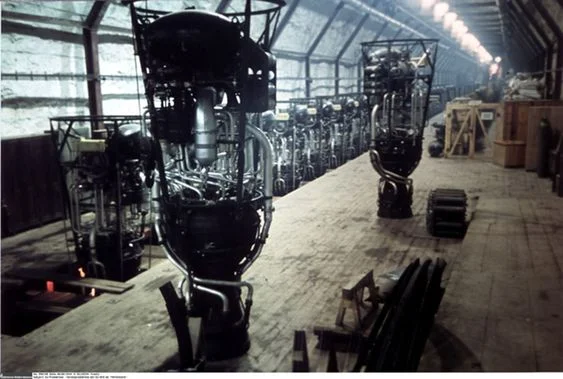 Germany, Nordhausen, concentration camp Dora-Mittelbau, prisoners manufacture V-1 & V-2 rockets 1944
Germany, Nordhausen, concentration camp Dora-Mittelbau, prisoners manufacture V-1 & V-2 rockets 1944
Opel RAK drew crowds with impressive ground and air displays, inspiring spaceflight pioneers like von Braun. However, the Great Depression halted these efforts. Von Opel left Germany in 1930, relocating to France and Switzerland.
Starting in 1930, von Braun joined the Technical University of Berlin and collaborated with Oberth on liquid-fueled rocket motor tests.
When the Nazi Party rose to power, artillery captain Walter Dornberger secured an Ordnance Department research grant for von Braun. He worked near Dornberger’s solid-fuel rocket test site at Kummersdorf.
Von Braun’s classified thesis, “Theoretical and Experimental Solution to the Problem of the Liquid Propellant Rocket” (dated 16 April 1934), remained unpublished until 1960. By the end of 1934, his team had successfully launched rockets reaching heights of 2.2 and 3.5 km.
Dornberger Outlined Military Requirements
During that period, Germans took interest in American physicist Robert H. Goddard’s research. German engineers and scientists sometimes contacted Goddard directly before 1939 for technical advice.
Von Braun utilized Goddard’s plans from various journals, incorporating them into the Aggregate (A) series of rockets, named for the German word for mechanism.
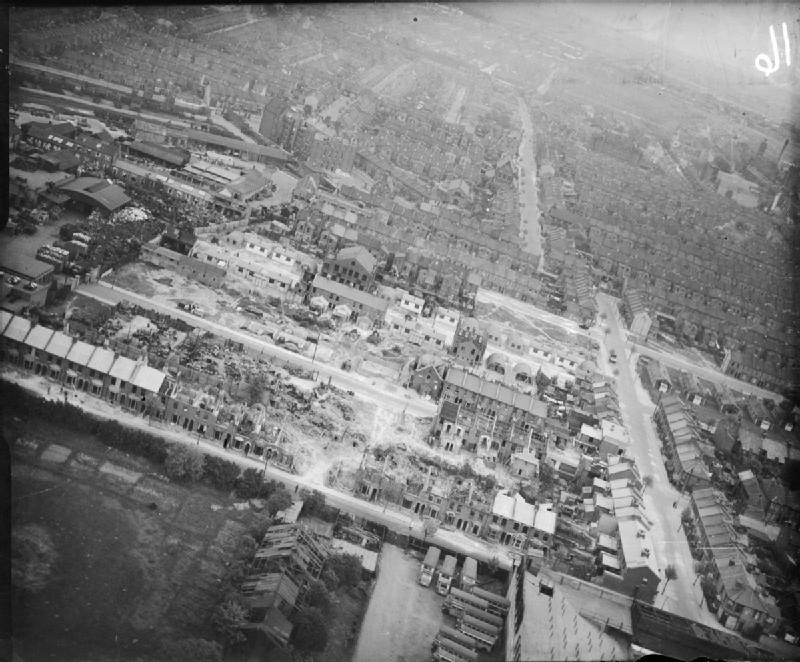 The extent of damage caused to a London residential area due to a single V-2 strike in January 1945.
The extent of damage caused to a London residential area due to a single V-2 strike in January 1945.
Following successful Kummersdorf tests with the first two Aggregate series rockets, Braun and Walter Riedel contemplated a larger rocket in the summer of 1936.
This new design was based on a projected 25,000 kg (55,000 lb) thrust engine. Additionally, Dornberger outlined military requirements, including a 1-ton payload, a range of 172 miles with a dispersion of 2 or 3 miles, and transportability via road vehicles.
After the A-4 project faced delays due to unfavorable aerodynamic stability tests on the A-3 in July 1936, Braun outlined A-4 performance in 1937.
Extensive A-5 scale model tests followed, featuring a motor redesigned by Walter Thiel. Construction of the A-4 was ordered around 1938-39.
 Incredible original color image of a captured German V-2 rocket launch at White Sands Proving Ground, New Mexico, on May 10, 1946.
Incredible original color image of a captured German V-2 rocket launch at White Sands Proving Ground, New Mexico, on May 10, 1946.
Between September 28-30, 1939, the Der Tag der Weisheit (The Day of Wisdom) conference convened at Peenemünde, initiating funding for university research to address rocket challenges.
By late 1941, the Army Research Center at Peenemünde possessed crucial technologies for A-4 success: large liquid-fuel rocket engines, supersonic aerodynamics, gyroscopic guidance, and jet control rudders.
At that time, Adolf Hitler wasn’t particularly impressed by the V-2, considering it an artillery shell with extended range and higher costs.
Slave Labour
In early September 1943, Braun assured the Long-Range Bombardment Commission that A-4 development was almost complete. However, by mid-1944, a full A-4 parts list remained unavailable.
 20,000 people died through hard labour building the V-2
20,000 people died through hard labour building the V-2
Hitler, impressed by the developers’ enthusiasm and needing a morale-boosting “wonder weapon,” authorized its large-scale deployment. The V-2s were constructed at the Mittelwerk site, using prisoners from Mittelbau-Dora, a concentration camp where 20,000 died.
In 1943, the Austrian resistance, including Heinrich Maier, sent precise V-2 rocket drawings to the American Office of Strategic Services. Location sketches of V-rocket manufacturing facilities, like Peenemünde, were also sent to the Allied general staff for airstrikes, crucial for Operations Crossbow and Hydra. However, most group members were captured and executed by the Gestapo.
The Tech Behind the V-2 Rocket
The A-4 utilized a 75% ethanol and 25% water fuel mix (B-Stoff) along with liquid oxygen (LOX) as the oxidizer (A-Stoff). Water in the mix reduced flame temperature, acted as a coolant, enhanced thrust, produced a smoother burn, and reduced thermal stress.
 Layout of a V-2 rocket.
Layout of a V-2 rocket.
Aerodynamic properties and center of pressure for the A-4 were measured using Rudolf Hermann’s supersonic wind tunnel. Measurements were conducted at Mach 1.86 on August 8, 1940, and further tests at Mach 1.56 and 2.5 were conducted after September 24, 1940.
Upon launch, the A-4 propelled itself for up to 65 seconds under its power. A program motor maintained the specified angle until engine shutdown. After that, the rocket followed a ballistic free-fall trajectory, reaching a height of 80 km (50 mi) after engine shutdown.
Fuel and oxidizer pumps were powered by a steam turbine, with steam generated by concentrated hydrogen peroxide (T-Stoff) and sodium permanganate (Z-Stoff) catalyst. Both alcohol and oxygen tanks were constructed from an aluminum-magnesium alloy.
The fuel and oxidizer pumps operated via a steam turbine. Steam was produced using concentrated hydrogen peroxide (T-Stoff) with a sodium permanganate (Z-Stoff) catalyst. Both alcohol and oxygen tanks were constructed from an aluminum-magnesium alloy.
Thrust Increased to 25 Tons
The turbopump, spinning at 4,000 rpm, forcefully directed alcohol and oxygen into the combustion chamber at a rate of 125 liters (33 US gallons) per second.
These substances were ignited by a spinning electrical igniter. Initially, thrust was at 8 tons, relying on gravity feeding for fuel.
 The V-2 was designed to deliver a one-ton warhead, making it a devastating weapon.
The V-2 was designed to deliver a one-ton warhead, making it a devastating weapon.
As the turbopump pressurized the fuel, thrust increased to 25 tons, lifting the 13.5-ton rocket. Combustion gases exited the chamber at temperatures of 2,820 °C (5,100 °F) and speeds of 2,000 m (6,600 ft) per second.
The oxygen-to-fuel mixture was 1.0:0.85 at 25 tons of thrust, but with decreasing ambient pressure at higher altitudes, thrust increased, eventually reaching 29 tons.
Read More: Hangar One so Large it has its Own Microclimate
The turbopump assembly featured two centrifugal pumps, one for alcohol and one for oxygen. The turbine was directly connected by a shaft to the alcohol pump and connected to the oxygen pump through a flexible joint and shaft.
A sodium permanganate catalyst converted hydrogen peroxide to steam, powering the pump, which delivered 55 kg (121 lb) of alcohol and 68 kg (150 lb) of liquid oxygen per second to a combustion chamber at 1.5 MPa (218 psi).
One Ton Warhead
Dr. Thiel’s 25-ton rocket motor innovation shifted from pressure feeding to pump feeding. It featured centrifugal injection, regenerative cooling, and film cooling.
Film cooling introduced alcohol into the combustion chamber and nozzle through small perforations. The injection head moved from the combustion chamber to a mixing chamber, which became more spherical and shorter.
 The rocket reached supersonic speeds during its flight, creating a characteristic sonic boom.
The rocket reached supersonic speeds during its flight, creating a characteristic sonic boom.
The connection to the nozzle became cone-shaped, resulting in a 1.5-ton chamber operating at 1.52 MPa (220 psi). This design was then scaled up to a 4.5-ton motor with three injection heads.
By 1939, the 25-ton motor incorporated eighteen injection heads in two concentric circles at the chamber’s head, made of 3 mm (0.12 in) thick sheet steel.
Read More: The Air Force’s 50,000 Ton Press
The warhead posed issues, containing amatol 60/40 detonated by an electric contact fuze. Despite being stable and protected by glass wool, it could still explode during re-entry. The warhead weighed 975 kilograms (2,150 lb) with 910 kilograms (2,010 lb) of explosive, constituting 93% of its weight.
Missile Guidance System
To prevent ice formation, the A-4 used a protective layer of glass wool for its fuel tanks, unlike other early ballistic missiles like the SM-65 Atlas. These tanks stored 4,173 kilograms (9,200 lb) of ethyl alcohol and 5,553 kilograms (12,242 lb) of oxygen.
The V-2 featured four external rudders and four internal graphite vanes for control. Helmut Hölzer’s Mischgerät analog computer managed these control surfaces through electrical-hydraulic servomotors.
 It was the world’s first long-range guided ballistic missile.
It was the world’s first long-range guided ballistic missile.
Gyroscopic systems like Siemens Vertikant LEV-3 and Kreiselgeräte’s SG-66 and SG-70 were used for stabilization and control.
The missile’s guidance system relied on two free gyroscopes and a PIGA accelerometer for engine cutoff. The V-2 was launched from a pre-surveyed location, ensuring known target distance and azimuth. Fin 1 of the missile was aligned with the target azimuth.
Some later V-2s employed “guide beams” – ground-transmitted radio signals. Initial models used analog computers for azimuth adjustment.
Engine cutoff timing was controlled by ground-controlled Doppler systems or on-board accelerometers. Range depended on engine burn time, terminating at a specific velocity. Just before cutoff, thrust decreased to eight tons to prevent water hammer issues caused by rapid cutoff.
V-2 Rocket Launches Still Used Beam Guidance
Dr. Friedrich Kirchstein from Siemens in Berlin developed V-2 radio control for motor cutoff (Brennschluss). Professor Wolman in Dresden created an alternative Doppler tracking system in 1940–41, using a ground signal transponded by the A-4 to measure missile velocity.
By February 9, 1942, Gerd deBeek from Peenemünde documented a V-2’s radio interference area as 10,000 meters around the “Firing Point.” The first successful A-4 flight on October 3, 1942, used radio control for Brennschluss.
 Fueling the V-2
Fueling the V-2
Although Hitler mentioned on September 22, 1943, that they had dispensed with the radio guiding-beam, about 20% of operational V-2 launches still used beam guidance.
The Operation Pinguin V-2 offensive began on September 8, 1944, with Lehr- und Versuchsbatterie No. 444 launching a rocket guided by a radio beam to Paris. Some combat V-2 wreckage contained the transponder for velocity and fuel cutoff.
Operational V-2s had a ragged-edged pattern, sometimes in plain olive green. In tests, a black-and-white chessboard pattern helped assess rocket spin.
Initially, the German designation was “V2,” unhyphenated, like aircraft prototypes. However, U.S. publications used “V-2” with a hyphen from December 1944 onwards.
Testing the V-2 Rocket
On October 3, 1942, the inaugural test flight succeeded, reaching an altitude of 84.5 kilometers (52.5 miles). The Allies recovered two test launches: the Bäckebo rocket, landing in Sweden on June 13, 1944, and one retrieved by the Polish resistance on May 30, 1944, from the Blizna V-2 missile launch site, transported to the UK during Operation Most III.
 Rocket engine used by V-2, Deutsches Historisches Museum, Berlin
Rocket engine used by V-2, Deutsches Historisches Museum, Berlin
The highest altitude achieved during the war was 174.6 kilometers (108.5 miles) on June 20, 1944. Test launches occurred at Peenemünde, Blizna, and Tuchola Forest during the war, and post-war launches took place at Cuxhaven by the British, White Sands Proving Grounds and Cape Canaveral by the U.S., and Kapustin Yar by the USSR.
Numerous design challenges were identified and successfully resolved throughout the development and testing of the V-2.
Things That Go Bang
Until mid-March 1944, only four of the 26 successful Blizna launches reached the Sarnaki target area as others broke up during re-entry into the atmosphere.
Initially, the suspected cause was excessive alcohol tank pressure. However, by April 1944, after five months of test firings, the exact cause remained undetermined.
Major-General Rossmann recommended stationing observers in the target area, leading Dornberger and von Braun to establish a camp in the Poland target zone around May/June.
Later, at the Heidekraut, SS Mortar Battery 500 of the 836th Artillery Battalion (Motorized) was ordered on August 30 to conduct test launches of eighty ‘sleeved’ rockets.
Testing confirmed that the ‘tin trousers,’ designed to strengthen the forward end of the rocket cladding, reduced the likelihood of air bursts.
On March 27, 1942, Dornberger proposed production plans and a launching site on the Channel coast. In December, Speer ordered Major Thom and Dr. Steinhoff to reconnoiter the site near Watten.
Assembly rooms were established at Peenemünde and Zeppelin Works’ Friedrichshafen facilities. In 1943, a third factory, Raxwerke, was added. Hitler signed the mass production order on December 22, 1942, with the expectation of final technical data by July 1943. However, many issues remained unresolved by autumn 1943.
Speer Was In
On January 8, 1943, Dornberger and von Braun met with Speer. Speer committed to start building the launching site on the Channel coast and established an A-4 production committee under Degenkolb.
On May 26, 1943, the Long-Range Bombardment Commission, chaired by AEG director Petersen, convened at Peenemünde to review the V-1 and V-2 automatic long-range weapons.
In attendance were Speer, Air Marshal Erhard Milch, Admiral Karl Dönitz, Col. General Friedrich Fromm, and Karl Saur. Both weapons had reached the final development stage, and the commission recommended mass production of both, recognizing that each had its advantages to compensate for the other’s disadvantages.
On July 7, 1943, Major General Dornberger, von Braun, and Dr. Steinhof briefed Hitler in his Wolf’s Lair, with Speer, Wilhelm Keitel, and Alfred Jodl also present.
Von Braun showcased a movie featuring the successful October 3, 1942 launch, complete with scale models of the Channel coast firing bunker and supporting vehicles, like the Meillerwagen. Hitler then prioritized Peenemünde in the German armaments program and expressed regret for not believing in their work earlier.
Saur planned to produce 2,000 rockets per month using the existing three factories and the under-construction Nordhausen Mittelwerk factory. However, alcohol production depended on the potato harvest.
Heavy Losses
A production line at Peenemünde was nearly ready when Operation Hydra attacked. Targets included test stands, development works, Pre-Production Works, the settlement, Trassenheide camp, and the harbor sector.
Dornberger noted that damage to the works was surprisingly small. Work resumed after a four to six-week delay, and the use of camouflage to mimic destruction prevented further raids for nine months.
The raid caused 735 casualties, with heavy losses in Trassenheide and 178 in the settlement, including Dr. Thiel, his family, and Chief Engineer Walther.
Production was eventually moved to the underground Mittelwerk in the Kohnstein, where 5,200 V-2 rockets were built using forced labor.
The V-2 Launch Sites
After the Operation Crossbow bombing, plans to launch from massive underground bunkers like Watten, Wizernes, and Sottevast or fixed pads like near the Château du Molay were abandoned. Instead, mobile launching became the preferred option.
 Ruined buildings at Whitechapel, London, left by the penultimate V-2 to strike the city on 27 March 1945; the rocket killed 134 people.
Ruined buildings at Whitechapel, London, left by the penultimate V-2 to strike the city on 27 March 1945; the rocket killed 134 people.
Eight main storage dumps were planned, and four were completed by July 1944 (Mery-sur-Oise began construction in August 1943 and finished in February 1944). The missile’s mobility allowed launches from practically anywhere, with forested roads being a common choice.
The system was so compact that only one Meillerwagen was ever caught in action by Allied aircraft, during the Operation Bodenplatte attack on January 1, 1945, near Lochem, targeted by a USAAF 4th Fighter Group aircraft. Raymond Baxter mentioned flying over a launch site with his wingman firing at the missile but missing.
It was estimated that a sustained rate of 350 V-2s could be launched per week, with the potential for up to 100 per day, provided there was a sufficient supply of rockets.
Operational Log
In late November 1943, the LXV Armeekorps z.b.V., led by General der Artillerie z.V. Erich Heinemann, formed in France and took charge of V-2 operations. Three launch battalions were established: Artillerie Abteilung 836 (Mot.) in Grossborn, Artillerie Abteilung 485 (Mot.) in Naugard, and Artillerie Abteilung 962 (Mot.).
Combat operations began in September 1944, starting with the deployment of Training Batterie 444.
On September 2, 1944, the SS Werfer-Abteilung 500 was created, and in October, SS Lt. Gen Hans Kammler assumed operational control over all units.
 Prisoners of the Dora-Mittelbau concentration camp work on the electronics of the V-2 rocket. This was Shop No. 28 manned by French, Dutch, and Belgians.The prisoner on the far end of the right hand bench, looking at the camera, was as survivor, Leon Navarro, a Frenchman, who recognized himself in the photo 55 years later.
Prisoners of the Dora-Mittelbau concentration camp work on the electronics of the V-2 rocket. This was Shop No. 28 manned by French, Dutch, and Belgians.The prisoner on the far end of the right hand bench, looking at the camera, was as survivor, Leon Navarro, a Frenchman, who recognized himself in the photo 55 years later.
He organized Gruppe Sud with Art. Abt. 836 in Merzig and Gruppe Nord with Art. Abt. 485 and Batterie 444 in Burgsteinfurt and The Hague.
After Hitler’s declaration on August 29, 1944, to initiate V-2 attacks as soon as possible, the offensive began on September 7, 1944, with two rockets launched at Paris (which the Allies had recently liberated), both of which crashed soon after launch.
On September 8, a single rocket was launched at Paris, causing modest damage near Porte d’Italie. Two more launches by the 485th battalion followed, including one from The Hague against London on the same day at 6:43 pm.
The first rocket landed at Staveley Road, Chiswick, resulting in casualties, while the other hit Epping without causing any injuries.
Waffen-SS
The British government, initially concealing the cause of explosions, blamed them on defective gas mains to prevent panic and intelligence leaks. The public dubbed the V-2s “flying gas mains” in disbelief.
Germany officially announced the V-2 on November 8, 1944, and Winston Churchill informed Parliament and the world on November 10, 1944, that England had been under rocket attack for several weeks. In September 1944, control of the V-2 mission shifted to the Waffen-SS and Division z.V.
The German launch units changed positions frequently. Artillerie Init 444, for instance, arrived in southwest Netherlands (Zeeland) in September 1944. They launched five V-2s on September 15 and 16, with one more successful and one failed launch on the 18th.
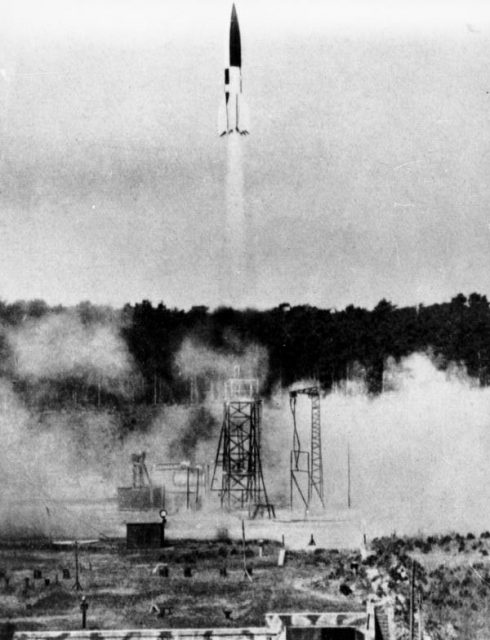 V-2 rocket launching, Peenemünde, on the north-east Baltic German coast. (1943) By Bundesarchiv – CC BY-SA 3.0 de
V-2 rocket launching, Peenemünde, on the north-east Baltic German coast. (1943) By Bundesarchiv – CC BY-SA 3.0 de
On the same date, a transport with a missile took a wrong turn and ended up in Serooskerke, allowing a villager to secretly photograph the weapon.
These photos were sent to London by the Dutch Resistance. Afterward, the unit moved to the woods near Rijs, Gaasterland, in northwest Netherlands to prevent Allied capture of the technology.
V-2s were launched from Gaasterland against Ipswich and Norwich from September 25, as London was out of range. Due to their inaccuracy, these V-2s did not hit their target cities.
Eventually, only London and Antwerp remained as designated targets, following orders from Adolf Hitler himself. Antwerp was targeted from October 12 to 20, after which the unit relocated to The Hague.
The Targets
Antwerp, Belgium, endured numerous V-weapon attacks from October 1944 to March 1945, resulting in 1,736 deaths and 4,500 injuries.
The city suffered 590 direct hits, causing extensive damage to thousands of buildings. The deadliest rocket attack during the war occurred on December 16, 1944, when the crowded Cine Rex theater was hit, leaving 567 dead and 291 injured.
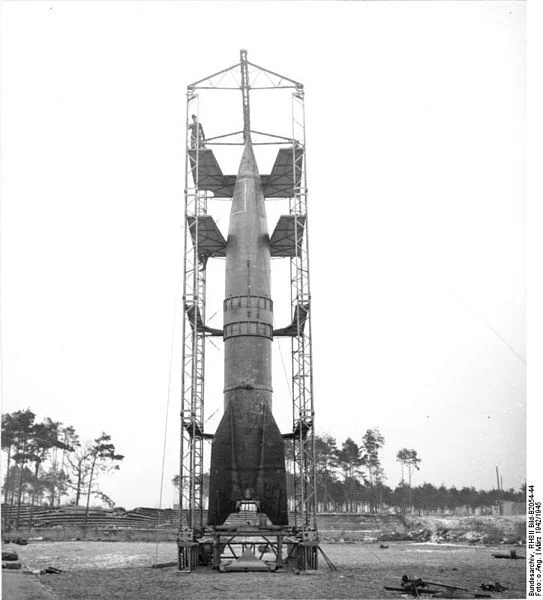 It had a maximum range of approximately 320 kilometers (200 miles) and could reach altitudes of up to 176 kilometers (109 miles).
It had a maximum range of approximately 320 kilometers (200 miles) and could reach altitudes of up to 176 kilometers (109 miles).
In London, an estimated 2,754 civilians were killed by V-2 attacks, with an additional 6,523 injured, averaging two deaths per V-2 rocket. However, this figure does not account for misdirected rockets that caused no harm.
Accuracy improved over time, especially when using the Leitstrahl (radio guide beam) system. One explosion at a Woolworth’s store in New Cross, south-east London, on November 25, 1944, killed 160 and seriously injured 108.
British intelligence used the Double-Cross System to send false reports, suggesting that V-2s were overshooting London by 10 to 20 miles. This strategy led to more rockets landing outside the city.
Most hit less densely populated areas in Kent due to inaccurate recalibration. Throughout the war, British intelligence continued the deception, repeatedly sending fake reports to imply that rockets were causing heavy casualties in London.
The Numbers
Belgium, 1,664: Antwerp (1,610), Liège (27), Hasselt (13), Tournai (9), Mons (3), Diest (2)
United Kingdom, 1,402: London (1,358), Norwich (43),[16]: 289 Ipswich (1)
France, 76: Lille (25), Paris (22), Tourcoing (19), Arras (6), Cambrai (4)
Netherlands, 19: Maastricht (19)
Germany, 11: Remagen (11)
The Last V-2 Rockets
The last two rockets detonated on March 27, 1945. One of them caused the final civilian casualty in the UK during the war. Ivy Millichamp, 34, lost her life in her Kent home on Kynaston Road.
A scientific study in 2010 revealed that a V-2 explosion creates a crater measuring 20 meters (66 feet) in width and 8 meters (26 feet) in depth, ejecting around 3,000 tons of debris into the air.
Assessment
The German V-weapons (V-1 and V-2) required an expenditure of roughly US$500 million. Given Germany’s smaller economy, this effort was comparable but slightly less than the U.S. Manhattan Project, which developed the atomic bomb.
A total of 6,048 V-2 rockets were produced, each costing approximately 100,000 ℛ︁ℳ︁ (£2,370,000 in 2011). Of these, 3,225 were launched.
SS General Hans Kammler, an engineer known for constructing concentration camps, including Auschwitz, proposed using camp prisoners as slave labor for the rocket program. Tragically, more people perished during the manufacturing of the V-2 than due to its deployment.
 A-4 Number 3 is prepared for launch at White Sands Proving Grounds, New Mexico, 10 May 1946. With a burn time of 59 seconds, the rocket reached an altitude of 70.9 miles
A-4 Number 3 is prepared for launch at White Sands Proving Grounds, New Mexico, 10 May 1946. With a burn time of 59 seconds, the rocket reached an altitude of 70.9 miles
The V-2 significantly strained Germany’s fuel alcohol production and other vital resources. Distilling fuel alcohol for one V-2 launch required 30 tonnes of potatoes when food was scarce.
Some warheads lacked explosives and were filled with concrete, using kinetic energy alone for destruction. Occasionally, warheads contained propaganda photos of Germans killed in Allied bombings.
The V-2 had a substantial psychological impact, offering no warning before impact, unlike planes or the V-1 flying bomb. American pilot William Liscum Borden saw one on its way to London and realized the potential for transoceanic rocket attacks.
With the war nearly lost, the Nazis turned to V-weapons as a last-ditch effort to influence the war and maintain hope among sympathizers. While the V-2 didn’t change the war’s outcome, it paved the way for intercontinental ballistic missiles and space exploration.
Post War Arms Race
After WWII, a competition arose between the United States and the USSR to acquire V-2 rockets and personnel. The U.S. captured 300 rail-car loads of V-2s and 126 key designers, including Wernher von Braun and Walter Dornberger. Von Braun and others chose to surrender to the U.S. (Operation Paperclip) to avoid Soviet capture or Nazi execution.
Following the Nazi defeat, German engineers were relocated to the United States, USSR, France, and the UK. There, they continued to develop the V-2 rocket for various military and civilian applications. The V-2 also served as the basis for future liquid fuel missiles and space launch vehicles.
Operation Paperclip – the Brain Drain
Operation Paperclip enlisted German engineers, while Special Mission V-2 transported captured V-2 parts to the U.S. More than 300 rail cars carried V-2 components to Las Cruces, New Mexico. Subsequently, these parts were trucked to the White Sands Proving Grounds in the same state.
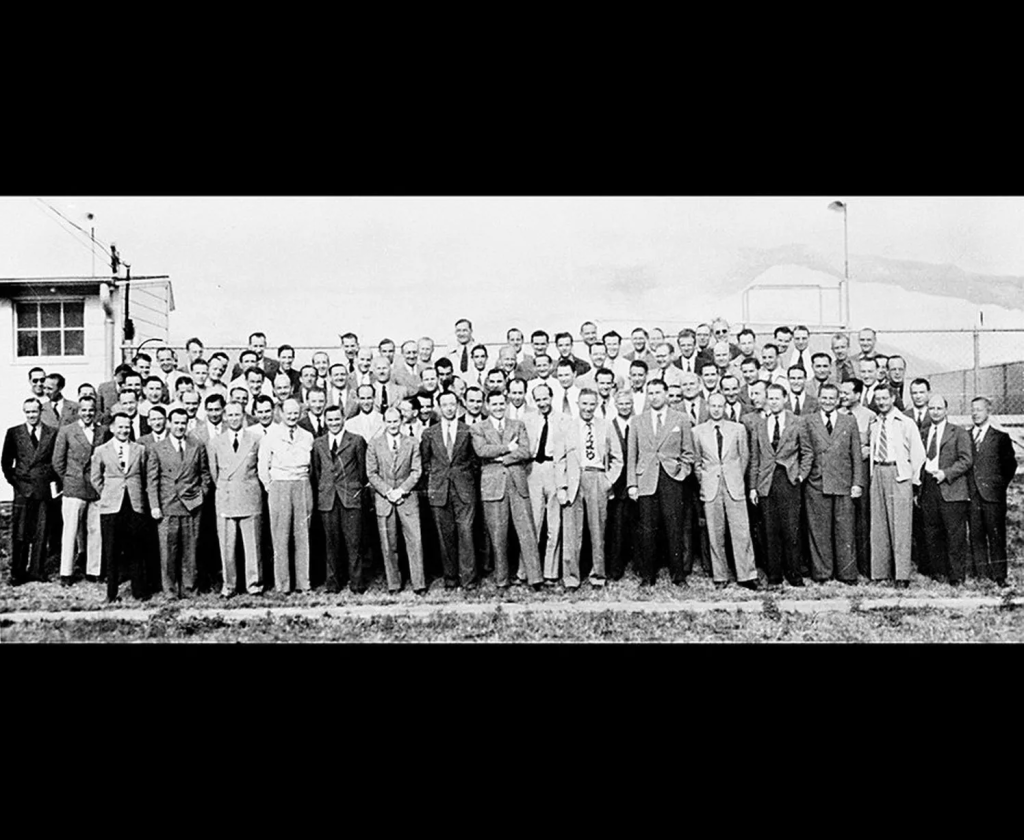 A group of 104 Operation Paperclip rocket scientists assemble at Fort Bliss, Texas
A group of 104 Operation Paperclip rocket scientists assemble at Fort Bliss, Texas
Along with V-2 hardware, the U.S. government provided German mechanization equations for guidance, navigation, and control systems to defense contractors for analysis.
These equations aided in developing navigation concepts for early U.S. programs like Atlas, Minuteman, and the Navy’s Subs Inertial Navigation System.
A committee of military and civilian scientists reviewed payload proposals for reassembled V-2 rockets. In January 1946, the U.S. Army Ordnance Corps invited civilian scientists and engineers to collaborate on a space research program using V-2s.
 US test launch of a Bumper V-2.
US test launch of a Bumper V-2.
Initially, the committee was known as the “V2 Rocket Panel” and later evolved into the “Upper Atmosphere Rocket Research Panel.” These efforts supported experiments that prepared for American manned space exploration, including atmospheric sampling and cosmic research.
Only 68 percent of V-2 trials were successful. On May 29, 1947, a supposed V-2 landed near Juarez, Mexico, but it was a Hermes B-1 vehicle.
 V-2 at White Sands Proving Grounds
V-2 at White Sands Proving Grounds
The U.S. Navy made a sea launch attempt from the USS Midway on September 6, 1947, as part of Operation Sandy. The launch was partially successful; the V-2 lifted off but splashed down about 10 km (6 mi) from the carrier. The launch setup on the Midway’s deck featured foldaway arms to prevent the missile from tipping over.
This setup differs from the R-7 Semyorka launch procedure, where the trusses bear the rocket’s full weight. The PGM-11 Redstone rocket directly descended from the V-2.
The V-2 Rocket and the USSR
The USSR captured V-2s and staff, allowing them to stay in Germany initially. Work contracts were signed in mid-1945. In October 1946, they relocated to Gorodomlya Island in Lake Seliger, directed by Helmut Gröttrup.
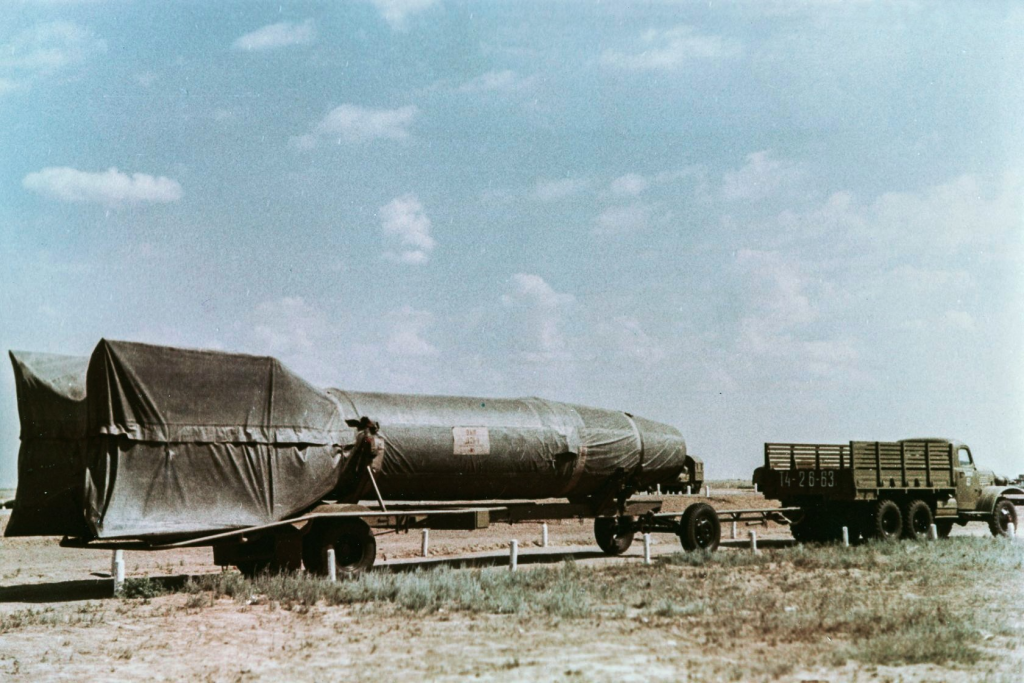 R-1 rocket (V-2 rebuilt by the Soviet Union) on a Vidalwagen at Kapustin Yar
R-1 rocket (V-2 rebuilt by the Soviet Union) on a Vidalwagen at Kapustin Yar
In October 1947, German scientists assisted the USSR in launching rebuilt V-2s in Kapustin Yar. Sergei Korolev indirectly oversaw the German team. The first Soviet missile, the R-1, a duplicate of the V-2, was launched in October 1948.
From 1947 to 1950, the German team developed concepts for extended payload and range, including projects G-1, G-2, and G-4.
They remained on Gorodomlya Island until 1952-1953. Simultaneously, the USSR developed larger missiles, the R-2 and R-5, based on V-2 technology with German concept studies. Details of Soviet achievements were underestimated until the successful launch of Sputnik 1 in November 1957.
In autumn 1945, a group at the NII-4 rocket artillery institute developed the first stratospheric rocket project, Project VR-190, using captured German V-2 rockets for vertical flight to an altitude of 200 km.
The V-2 Rocket & France
Between May and September 1946, CEPA, the precursor to CNES, recruited around thirty German engineers with Peenemünde experience. France aimed to acquire and advance German rocket technology.
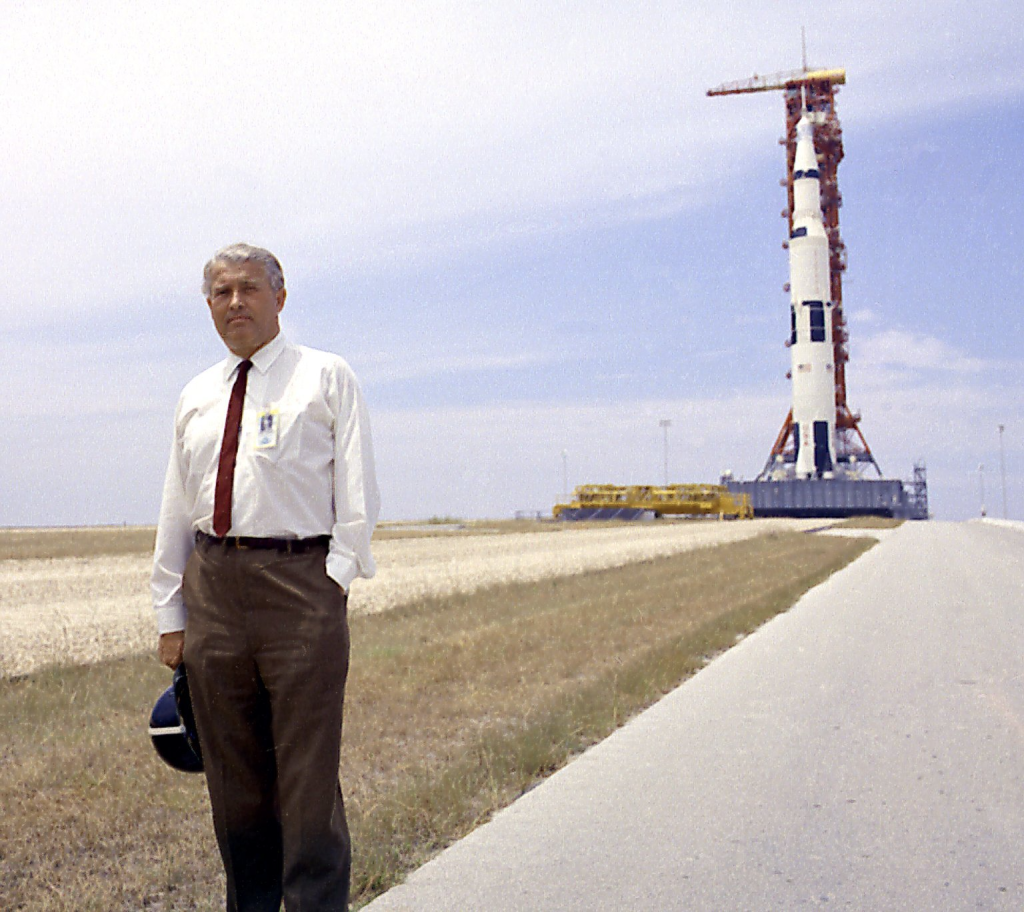 Dr. von Braun pauses in front of the Apollo 11/Saturn V at the Kennedy Space Center (KSC). (NASA MSFC-6901046)
Dr. von Braun pauses in front of the Apollo 11/Saturn V at the Kennedy Space Center (KSC). (NASA MSFC-6901046)
The Super V-2 program, canceled in 1948, planned four rocket variants with ranges up to 3,600 km and 1,000 kg warheads. From 1950 to 1969, research from the Super V-2 program contributed to the development of the Véronique sounding rocket, the first Western European liquid-fuel research rocket.
It could carry a 100 kg payload to 320 km altitude. This program eventually led to the Diamant and Ariane rocket family.
The V-2 Rocket & the UK
In October 1945, Operation Backfire gathered a few V-2 missiles and launched three from northern Germany. The engineers involved planned to move to the US after the test firings.
The Backfire report, published in January 1946, provides detailed technical information about the rocket, including support procedures, customized vehicles, and fuel composition.
In 1946, the British Interplanetary Society proposed an expanded version of the V-2 for carrying humans, named Megaroc. This concept could have enabled sub-orbital spaceflight, potentially preceding the Mercury-Redstone flights of 1961 by a decade or more.
Survivors
During World War II, a total of approximately 6,048 V-2 rockets were produced by Nazi Germany. These were developed and manufactured as part of the V-2 rocket program led by engineers like Wernher von Braun. With current data, only 20 WW2 V-2 rockets survive, and are now in museums.
News
The Hanging Temple: China’s 1,500-Year-Old Cliffside Marvel of Faith and Engineering
The Hanging Temple: China’s 1,500-Year-Old Cliffside Marvel of Faith and Engineering Perched precariously on the cliffs of Mount Heng in Shanxi Province, China, the Hanging Temple, also known as Xuankong Temple, Hengshan Hanging Temple, or Hanging Monastery, is an architectural…
The Willendorf Venus: A 30,000-Year-Old Masterpiece Reveals Astonishing Secrets
The Willendorf Venus: A 30,000-Year-Old Masterpiece Reveals Astonishing Secrets The “Willendorf Venus” stands as one of the most revered archaeological treasures from the Upper Paleolithic era. Discovered in 1908 by scientist Johann Veran near Willendorf, Austria, this small yet profound…
Unveiling the Maya: Hallucinogens and Rituals Beneath the Yucatán Ball Courts
Unveiling the Maya: Hallucinogens and Rituals Beneath the Yucatán Ball Courts New archaeological research has uncovered intriguing insights into the ritual practices of the ancient Maya civilization. The focus of this study is a ceremonial offering found beneath the sediment…
Uncovering the Oldest Agricultural Machine: The Threshing Sledge’s Neolithic Origins
Uncovering the Oldest Agricultural Machine: The Threshing Sledge’s Neolithic Origins The history of agricultural innovation is a fascinating journey that spans thousands of years, and one of the earliest known agricultural machines is the threshing sledge. Recently, a groundbreaking study…
Nara’s Ancient Sword: A 1,600-Year-Old Protector Against Evil Spirits
Nara’s Ancient Sword: A 1,600-Year-Old Protector Against Evil Spirits In a remarkable discovery that has captured the attention of archaeologists and historians alike, a 7.5-foot-long iron sword was unearthed from a 1,600-year-old burial mound in Nara, Japan. This oversized weapon,…
The Inflatable Plane, Dropped Behind the Lines for Downed Pilots
Experimental The Inflatable Plane, Dropped Behind the Lines for Downed Pilots The Inflatoplane from Goodyear was an unconventional aircraft developed by the Goodyear Aircraft Company, a branch of the renowned Goodyear Tire and Rubber Company, also famed for the Goodyear…
End of content
No more pages to load












